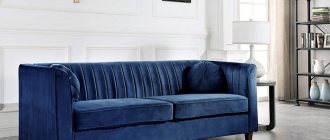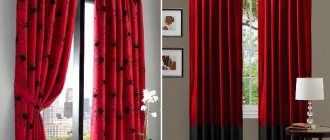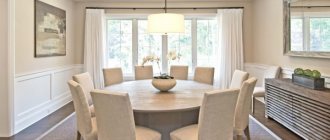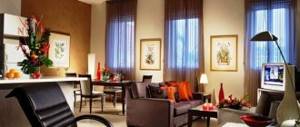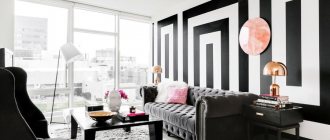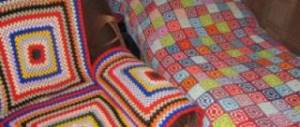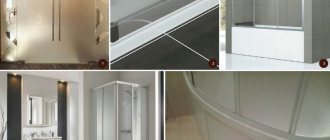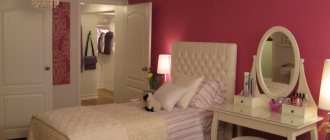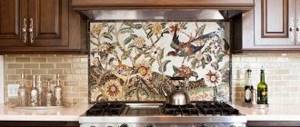When choosing an apron for the kitchen, it is important to pay attention not only to the “picture”, but also to the practicality of the material and design as a whole. First of all, this element of the interior must fulfill its intended purpose - to protect the wall between the work surface and wall cabinets from splashes of grease and water, not absorb dirt and be easy to clean. Smooth aprons made of ceramic tiles and tempered glass cope best with this task. More interesting in terms of design, but less practical are types made of stainless steel, plastic, wood, and natural stone. We suggest studying the comparative characteristics of different aprons to decide which one is better to choose.
Main selection criteria
Many people choose an apron for the kitchen only based on external features - whether it corresponds to modern trends, whether it matches the kitchen set, whether they like it or not. However, it is more correct to start considering the types of aprons from the materials from which they are made. The color and shape can be selected later. Fortunately, today technologies make it possible to apply all kinds of prints, photo printing, gold plating, imitate stone, play with colors, etc. on almost any material.
The main criteria for choosing an apron for the kitchen are wear resistance and ease of maintenance. It is more practical to choose a material with the following characteristics:
- smooth, without any depressions in which dirt can accumulate;
- shockproof;
- moisture resistant, non-porous;
- resistant to temperature changes;
- easy to clean, resistant to cleaning agents (does not scratch, does not fade).
In addition, a high-quality apron should have a minimum of joints. It's even better if it's made from a solid slab. If tiles are selected, moisture-resistant grout must be used. To seal the seams, special borders are used, which are placed on moisture-resistant silicone or sealant.
Magic outfit for the kitchen
There is one magical place in the kitchen space that effectively complements the kitchen set and serves as a connecting link between all the elements of kitchen decor.
This is the part of the wall between the kitchen countertop and wall cabinets, which in everyday life is called an apron. Most likely, it got its name by analogy with the housewife’s kitchen apron, which protects her clothes.
Our beautiful kitchen apron performs not only decorative functions, it must meet the following requirements:
- must reliably protect the walls from splashes of water, grease, and drinks;
- should be very easy to clean off dirt;
- designed to be sufficiently resistant to the effects of chemical detergents;
- and also quite resistant to mechanical stress;
- and also, quite resistant to temperature changes;
MDF - a simple and stylish solution
Design of a kitchen apron by analogy with an MDF countertop.
The simplest and easiest option would be to order an MDF apron along with the kitchen set. Then the apron and tabletop are made in the same style, only the thickness of the tabletop is greater than that of the apron panel.
The advantages of this option are the following:
- profitable price;
- simple installation and dismantling;
- Mounting holes for sockets are easily cut.
The disadvantages of MDF aprons are expressed by the following disadvantages:
- fragility, over time the surface may warp from water and chemical reagents;
- MDF has a low degree of fire safety and can release toxic substances when burned.
The chipboard countertop option is ideal for those who want to get a beautiful apron for their kitchen without much effort.
Advice. When installing an MDF apron with your own hands, pay attention to the joint between the horizontal plane of the tabletop and the vertical plane of the apron. This joint must be closed with a special corner. The color of the corner is matched to the color of the panels or the color of the kitchen fittings.
Tile - a classic solution
The photo shows a version of a ceramic tile apron with decorative inserts and borders.
Tiles in kitchen decoration are classics of many popular styles. Original design options for a kitchen backsplash made of tiles, mosaics, and porcelain stoneware are widely used by designers.
And this choice is due to good reasons:
- availability of material;
- a wide range of;
- wide selection of designer collections;
- easy to care for kitchen wall apron made of ceramics;
- moisture resistance;
- resistance to chemical detergents;
- resistance to mechanical stress;
- resistance to temperature changes.
Advice. When laying tiles or mosaics with your own hands, do not forget to thoroughly level the wall surface first. It is advisable to start laying the tiles from below, retreating 1-2 centimeters below the countertop. The gap between the countertop and the tile is closed with a corner in the color of the countertop.
Skinali - a modern solution
Individual design of a kitchen apron using skinali.
Recently, kitchen aprons made from special tempered glass have become widespread.
This apron is made from the following glass:
- matte;
- transparent;
- mirror;
- with sandblasting pattern;
- with photo printing.
The option of making an apron with photo printing has won the hearts of many housewives. After all, you can order an apron with any individual design, with a photo print of a poster that no one else has.
The advantages of glass aprons are undeniable, they are:
- easy to clean;
- resistant to cleaning agents;
- original;
- environmentally friendly;
There are disadvantages, as without them, but they relate mainly to the caution with which you need to approach the choice of design. You need to choose a design that won’t get boring over time and won’t cause irritation.
Top 5 types of aprons
The most popular today are kitchen aprons made of glass (skinali), artificial stone, plastic and MDF. Also, the classic – ceramic tiles – never goes out of style. All types are good in their own way. To understand which one best suits personal preferences and financial capabilities, we suggest studying the comparative characteristics.
Glass
The kitchen apron is made of tempered glass - it is very durable and easy to clean. With its help you can implement almost any design solution. For example, using transparent glass, emphasize the beauty of wall decoration, or place decorative film with photo printing, dried flowers, or children's drawings between two glasses. For finishing you can choose frosted glass, textured, colored and even mirrored. There are plenty of options.
Advantages of a glass apron:
- has an aesthetic appearance;
- many design variations;
- hygienic;
- durable,
- lasting;
- heat resistant.
We recommend: How to choose high-quality knives for the kitchen?
Flaws:
- easily soiled;
- expensive;
- relatively fragile.
MDF apron
A budget option, but at the same time quite practical. An MDF (medium density fibreboard) backsplash is often included with kitchen units. You can also choose it separately; the product is quickly manufactured and easy to install. There are also many color variations: stone finishes, mosaics, tiles, drawings, photo printing, etc.
Advantages of MDF apron for the kitchen:
- low price;
- easy installation and dismantling;
- quite moisture resistant and durable;
- hygienic;
- universal, suitable for almost any stylistic solution.
The main disadvantage of such an apron is its low heat resistance. If a gas stove is placed nearby, in the event of a fire, the fire will spread quickly. The second disadvantage of the material is its tendency to deform. It cannot be called durable; its service life ranges from 5 to 10 years.
Ceramic tile
The tiled apron is a leader in practicality and price/quality ratio. Many will call this option old-fashioned - and they will be wrong. Today there are so many types of tiles that they can satisfy the most demanding taste: mosaic, textured, voluminous, with a metal coating, intricate patterns, embossing (for example, leather), large and small, combined sizes. The list can be endless. Let’s move on to the advantages of a ceramic tile backsplash:
- hygienic – does not stain, is easy to clean, does not absorb moisture and fat;
- heat-resistant – does not burn, does not melt;
- diverse - with it you can bring to life a lot of decor ideas;
- durable - does not scratch, does not leave dents;
- durable – service life from 15 to 50 years;
- completely safe - does not accumulate static electricity, does not conduct current.
There are few disadvantages to tiles:
- complexity of dismantling and installation;
- the need to level the wall before work;
- the presence of seams between the tiles, which reduce hygiene and require additional care.
Plastic
The characteristics of a plastic apron are comparable to those of MDF. It often comes complete with furniture, comes in a variety of shapes and shades, and is easy to install. There are several types: carbonate glass, PVC panels, vinyl, lining and laminate. But if the first two materials are considered relatively durable, hygienic and safe, then using the rest for installation next to the hob is simply reckless. Not only can they burst into flames instantly, but they are also easily deformed by temperature changes, and when heated, they release toxic substances into the air.
Apron made of liquid artificial stone
One of the most expensive aprons for the kitchen. Its undoubted advantages are the ability to create a single composition with the countertop and sink and easy restoration. Scratches or other defects are eliminated with the same putty from which the apron is made. It is made from acrylic or quartz agglomerate. The first is essentially plastic, is flammable and easily deteriorates. But quartz agglomerate really deserves attention. He is afraid of only one thing - bleach (loses color).
We recommend: Why do we need silicone insoles, how to choose them and how to care for them?
Advantages:
- hygienic;
- lasting;
- durable;
- “expensive” in appearance;
- heat resistant;
- easy to restore;
- can be connected to the tabletop without a seam.
Flaws:
- high price;
- installed only by specialists;
- limited choice of colors.
Glass aprons and photo printing options
Glass decorative panels are much more expensive than ceramic tiles, but in the future the high cost pays off in the first year of use. This kitchen apron is durable, strong and original. Thanks to the latest photo printing technologies, when applied to glass, the brightness and durability of the image is guaranteed for a long time. If you save money and order glass in which the image is applied to the kitchen apron on film, then after a short time the image will fade, fade, and even bubble near the hob.
The glass apron can be made in the following options:
- Transparent or frosted glass without image or color.
The transparent apron is invisible and disappears into the room
The main purpose is to protect the wall covered with wallpaper or painted from contamination. Frosted glass looks more expensive and does not produce glare. Flat glass is not necessarily dull and smooth. There are panels on sale with a structured surface or inscriptions made using silk-screen printing or laser processing.
- Glass with UV printing (skinned for the kitchen). This type of finishing has been deservedly popular for several years. Pictures for a glass apron are applied to the “wrong side” of the panel. The image does not lose color over time, since UV ink does not fade and is resistant to high temperatures. It is important to choose the right skins to match the color of the kitchen.
- Painted glass. This is a winning choice for those who are afraid to experiment with bright patterns of kitchen aprons. The plain panel looks stylish, but does not attract undue attention. This apron is strong and durable, since the panel is painted using a special technology and then undergoes a heat treatment process.
- Panel with a pattern on film. This is a budget option. A film with a pattern is glued to the “wrong side” of the glass. But over time, it wrinkles and fades. Near the hob, damage and defects appear faster, since the film, although protected by glass, cannot withstand high temperatures.
- Triplex. An apron for the kitchen with a pattern made of laminated glass is reliable and durable. A design is “baked” between two glass panels. With a strong impact, it does not break, but is simply covered with a network of cracks. They rarely buy it, since triplex is more expensive than other options.
- Mirror.
Will help increase space in a small kitchen
- For those who are not ready to constantly watch their work in reflection, matte mirror panels with laser engraving are suitable.
Many companies offer photo printing on backsplashes and production of glass panels. The glass for the apron has a thickness of 0.6 to 0.8 cm. For those who decide to install a glass panel in the kitchen, the catalog of designs will help you decide on the choice of design. The catalogs present many pictures for photo printing on a kitchen apron for every taste. For each specific room, you can choose the appropriate option both in color and interior style. If in the bank of images for kitchen aprons there is no design whose design fully meets the customer’s requirements, then companies offer the opportunity to develop a personal project. Then the client will receive a unique kitchen apron.
In order to focus attention on the skin, lighting is also installed there. There are two options: around the perimeter of the apron or inside. White LED strips are most often used. Colored tape makes it possible to change the shade of lighting in direct proportion to your well-being and mood.
Many people mistakenly think that skins are difficult to care for and cite as arguments the fact that fingerprints,
water drops and dirt particles are too noticeable on a smooth surface. But in reality, dirt on a glass backsplash is visible in the same way as on everyone’s favorite glossy ceramic tile. Any backsplash, even from Moroccan tiles in the kitchen, needs to be wiped and washed often. But the skinal has a significant advantage - it is much easier to clean, since the smooth, seamless surface is much easier to care for than ceramic tiles with countless seams in which dirt and germs constantly accumulate.
When choosing a material for an apron, designers recommend taking a closer look at bleached glass (Optiwhite). The fact is that ordinary glass seems transparent, but on the white background of the image for the skinal, a slightly greenish tint will be clearly visible. Therefore, if the drawings for the kitchen are colored, in bright and rich colors (landscape, still life, panorama), then you can get by with ordinary glass. If the background of the apron is light, then you should choose bleached Optiwhite. True, it costs 25-30% more. In addition, it was noticed that due to the greater transparency of Optiwhite, the image appears bright and clear.
Luxury and unusual aprons for the kitchen
Aprons made from the above materials are universal; you can use them to create any design in the kitchen. But for some this is not enough.
If you want something unusual, even at the expense of practicality, you should choose one of the following options:
- marble;
- from natural stone;
- made of natural wood;
- stainless steel;
- from pebbles;
- from a cut of brick;
- in the form of a board covered with slate paint.

